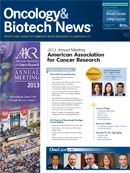Publication
Article
Oncology & Biotech News
Potential Druggable Targets Identified in Acute Myeloid Leukemia
Author(s):
Acute myeloid leukemia is potentially driven by at least one genetic mutation in nearly all cases, with a complex interaction of multiple genetic events contributing to the development of the disease
Richard Wilson, PhD
Acute myeloid leukemia (AML) is potentially driven by at least one genetic mutation in nearly all cases, with a complex interaction of multiple genetic events contributing to the development of the disease, according to findings published in the The New England Journal of Medicine.
AML is the most common acute form of leukemia in adults. Historically, researchers have had a somewhat difficult time determining how patients with AML would respond to various treatments. Approximately 50% of all cases of AML exhibit a normal karyotype, and although some of these cases respond well to chemotherapy, others have poor outcomes. Certain newly identified AML genes, such as DNMT3A, IDH1/2, and TET2, may provide prognostic information, but no current classification schemes have been entirely accurate.
In this study, researchers selected samples from 200 adults with de novo AML and analyzed their genomes using either whole-genome sequencing (n = 50) or whole-exome sequencing (n = 150). All samples were then subject to RNA and microRNA sequencing and DNA methylation analysis. All known subtypes of AML were represented in this patient population in approximately the same proportion as the general population. In each sample, the AML genome was compared with a normal genome obtained from a skin sample from the same patient.
The study also found that AML genomes have fewer mutations than most other adult cancers, with an average of 13 mutations in the genes, a figure much lower than the hundreds of mutated genes found in breast, lung, and pancreatic cancer. On average, five mutations were in genes that are recurrently mutated in AML. The researchers found a total of 23 genes that were significantly mutated, with another 237 genes mutated in at least two or more of the samples tested.
Additionally, nearly all of the samples had at least one nonsynonymous mutation in one of nine gene categories associated with pathogenesis, including mutations in transcription-factor fusions (18%), NPM1 (27%), tumor-suppressor genes (16%), DNA methylation—related genes (44%), signaling genes (59%), chromatin-modifying genes (30%), myeloid transcription-factor genes (22%), cohesion-complex genes (13%), and spliceosome-complex genes (14%).
“We’ve never had such a complete picture of AML, and this data set will be mined by researchers for years,” said Richard Wilson, PhD, study co-leader and director of Washington University’s Genome Institute, in a statement. “These findings have probably identified every pathway in which a modification– and perhaps new drugs–might be beneficial. They also further refine our understanding of the importance of individual mutations for disease classification and prognostication, and will help us build better disease models.”
Prior to this study, researchers knew that mutations in signaling genes were common in cases of AML, so they expected to see at least one signaling gene mutation in every sample. Surprisingly, this research found that only approximately 60% of cases in the study included mutations of signaling genes such as FLT3, which is responsible for normal blood cell development. Researchers also noted that patients exhibiting concurrent mutations of FLT3, NPM1, and DNMT3A may have a unique subtype of AML.
“This study of AML reinforces the value of the approach we are using to study the genomic diversity among tumors of many different cancer types and even within a single kind of cancer such as AML,” said Harold Varmus, MD, director of the National Cancer Institute, in a statement. “Only such a systematic analysis of cancer types could have uncovered such clear patterns, such as the apparent importance in AML of genetic mutations that lead to changes in gene expression and cell traits.”
The Cancer Genome Atlas Research Network. Genomic and epigenomic landscapes of adult de novo acute myeloid leukemia. N Engl J Med. 2013;368(22):2059-2074.










